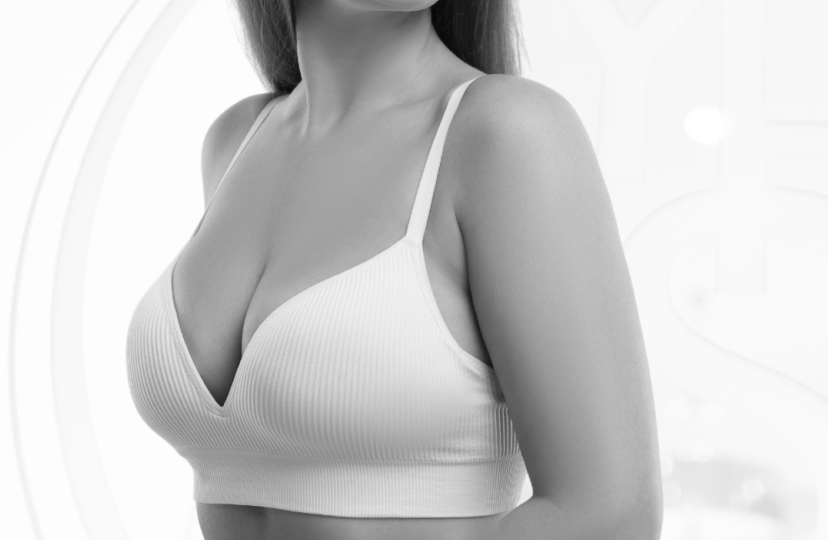
Patients seeking breast lift surgery are satisfied with the size of their breasts but want to improve their shape. Common reasons for change in breast shape include age-related sagging, and postpartum or post-breastfeeding changes. A breast lift improves the overall shape of the breast and returns the nipple to a higher position.
Many different breast lift operations have been described but there are three common types of mastopexy procedure performed by Dr. Andrade:
The periareolar mastopexy is also called the Benelli lift or donut mastopexy. It involves removing a circular strip of excess skin from around the edge of the areola. The scar is less visible because it is around the border of the areola, which is pigmented. Although this results in the least visible scarring of the three types of breast lift described here, relatively little skin is removed using the periareolar breast lift so in general less tightening is achieved with this type of operation.
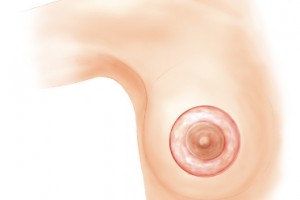
The vertical mastopexy removes skin from around the areola and from the lower part of the breast below the areola. It results in a scar around the nipple and a vertically oriented scar down the centre of the lower breast, which resembles a “lollipop”. More skin is removed with the the vertical breast lift which often allows for more reshaping of the breast and elevation of the nipple. However, if the breasts are very heavy and low, this operation may not remove enough tissue from the lower part of the breasts, resulting in a bottom-heavy look the the breasts.
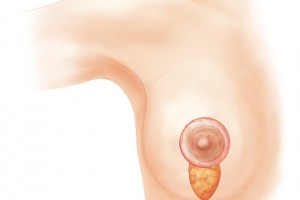
The inverted-T breast lift is also called an anchor scar lift, or Robbins mastopexy. It results in a scar around the nipple, down the front of the breast, and in the breast crease. This procedure removes the most skin from the breast but it also causes the most scarring. It is used for patients with nipples that are very low on the breast, or breasts that have severe sagging and loose skin. Examples of people who find this operation to be the best option are those who want the tightest result possible, who have had massive weight loss, or who have noticed that their nipples have dropped and their breasts have lost fullness after childbirth.
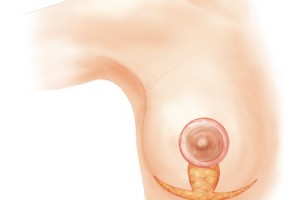
There is no “perfect” breast lift procedure, as they all have different advantages and disadvantages. In general, removing more skin and reshaping more of the underlying tissue allows the surgeon to greater reshape and “perk up” the breast. If you pinch the lower part of your own breast skin in a vertical direction you will notice that this tends to make the breast narrower and perkier, but if you pinch the breast tissue underneath along the crease, this also tends to push the tissue higher on chest, providing more upper fullness. During surgery, Dr. Andrade uses the “tailor-tacking” technique which involves putting temporary tacking sutures or staples in the skin and adjusting the shape of the breast, before making any final decisions or incisions on the breast. This permits him to remove as much loose skin as safely possible during the operation. Typically, internal sutures are also used to hold the breast tissue higher on the chest as it is healing.
Sometimes only a very minimal lift of one areola is required, in which case just a small crescent-shaped strip of skin can be removed above one areola. This is called a “crescentic mastopexy”. Other surgeons have described a “no vertical scar” mastopexy but a possible limitation of this procedure is a “boxy” look to the breast, or excessive puckering of the skin along the crease under the breasts.
Prior to any surgical procedure, a general physical examination by a family physician is recommended. Dr. Andrade is pleased to send a consultation letter to the family physician if the patient wishes to keep them informed of their operation.
For most healthy patients, routine preoperative blood tests and other tests usually do not need to be arranged prior to surgery (this is the recommendation of Choosing Wisely Canada). It is very important to inform Dr. Andrade about all medications, vitamins, and herbal supplements. Some of these substances can increase the risk of bleeding and must be stopped prior to surgery. Do not have anything to eat 8 hours before surgery. Clear fluids like water, tea without milk, or ginger ale may be consumed up to 3 hours before surgery. Never have milk, orange juice, soup or other liquid containing solids. A special surgical bra will be provided. Dr. Andrade and a registered nurse will review all of these details prior to the operation.
Breast lift surgery is performed under a general anesthetic, either in Dr. Andrade’s private facility in Newmarket, or at Southlake Regional Health Centre. The anesthetic is delivered by a board-certified Anaesthesiologist. The operation takes less than 2 hours but total time spent in the facility is approximately 4 hours.
Patients are given a prescription for a pain medication and stool softener to avoid constipation. Most people are doing their own self-care and other their light activities the day after surgery, but Dr. Andrade recommends avoiding heavy lifting or vigorous excercise involving the chest muscles for 4-6 weeks following surgery. Showering is permitted 48 hours postoperatively. Tapes (Steri-Strips) are glued to the skin and seal off the wound. They usually remain adherent for at least 10-14 days, after which time they may be removed. A scar reduction program will be prescribed by Dr. Andrade.
Immediately following mastopexy surgery, the breasts may be bruised, swollen, and tender, and the shape may appear unusual. Most of these symptoms resolve within a few weeks. The breast shape will continue to improve over 3-6 months, and scars generally soften and fade significantly by 6-12 months postoperatively.
The majority of patients are satisfied with the shape of their breasts following breast lift surgery, and the results usually last for many years. However, age-related changes to the breasts will continue to occur over time. Some patients may seek additional surgery in the future to improve the appearance of their breasts. Immediately after surgery, all patients will have some degree of breast pain, swelling, and bruising.
Uncommon problems immediately following breast lift surgery include but are not limited to bleeding, infection, wound healing problems, chronic pain, changes in breast or nipple sensation, or loss (necrosis) of the areola. Long-term problems can result such as asymmetry, puckering or irregularities of the breast or nipple area, or prominent scars. Rarely, life-threatening complications can arise during or after any operation. Dr. Andrade will discuss other specific risks and answer any questions during the consultation.
Although breast lift surgery elevates and tightens the breast, Dr. Andrade recommends that patients continue to wear a bra, particularly while playing sports or doing other vigorous activities. This will provide added support and help to maintain the longterm shape of the breast.
Scars usually start to soften and fade within 2-3 months following surgery and they continue to mature for at least 12-18 months. It is important to avoid tanning beds or suntanning while scars are immature, because they can become pigmented. Scar massage and certain topical gels and other treatments can help scars to mature and fade. Even if meticulous surgical technique is used and there are no immediate postoperative healing problems, the final appearance of scars is largely dependent upon each patient’s unique healing response. Some patients heal with fine, faint scars while others have more visible scars. Very prominent raised or symptomatic scars, called “hypertrophic scars” or “keloids”, are uncommon after breast surgery.
The breast lift procedure involves removing excess breast skin but usually all of the underlying glandular tissue is preserved (unless the patient specifically requests to have smaller breasts). Therefore the overall amount of breast tissue present before and after surgery is nearly the same. However, a different bra size or type may be required postoperatively because of the new breast shape.
During breast lift surgery, different techniques can be used to reshape and support the internal tissues to provide more longevity to the result. Various permanent or dissolving sutures, meshes or slings made from natural tissue have been used. Dr. Andrade prefers to use slowly dissolving sutures to reshape the deeper breast tissue, since permanent sutures or meshes can pose a long-term infection risk, or possibly distort the overlying tissue.
This term refers to using the existing tissue in the breast to provide more upper fullness. This is typically done by transferring tissue from the lower breast or lateral chest to the upper breast, while retaining its blood supply. This is different from fat grafting / lipofilling, in which loose fat is harvested from one part of the body and injected into the breast. Autoaugmentation does not involve adding more overall volume to the chest region, but rather creating a fuller-looking breast shape. In contrast, lipofilling actually adds to the volume of the breasts. Although the results of autoaugmentation are modest and do not compare with the results of breast augmentation using implants, this technique has several advantages. It is less time-consuming, expensive and there are few long-term risks. In the photo below, the patient had an unsightly roll of excess tissue lateral to the breast after losing weight. Rather than simply excising the tissue, it was was used to improve the shape of her breast.
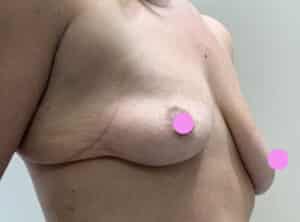

Our website contains before and after photos of Dr. Andrade’s patients with their treated anatomy exposed. These photos are intended to help our patients make an informed decision about surgery, and they are not testimonials or endorsements. Each person is unique therefore we cannot guarantee that you will achieve the same results. A thorough in-person consultation is necessary to understand your options and possible outcomes. By proceeding, you acknowledge that you are over 18 years of age.